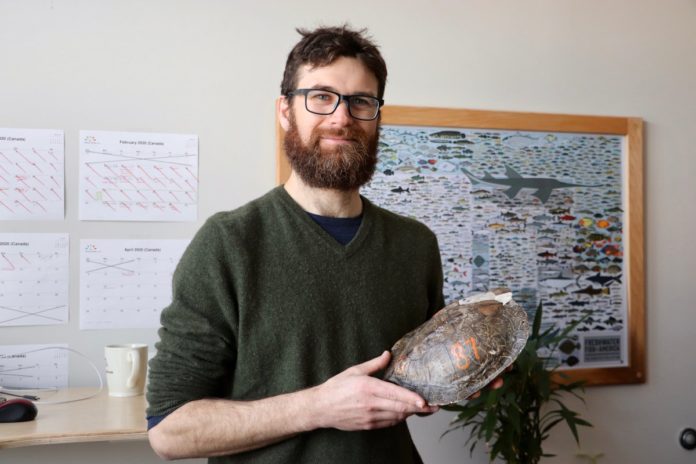
If you haven’t heard about Carleton University’s own turtle sex researcher, then you need to get out from under your shell.
If there was one thing Grégory Bulté thought would come out of his research into turtle mating, it certainly was not a reputation as Carleton’s resident “turtle voyeur,” he said.
Hand-crafted models normally used for reproductive research on turtle mating have been known to be rather expensive. But thanks to a study published in June 2018, the Carleton biology instructor won notoriety within the scientific community for being one of the first researchers to successfully use 3D-printed animal replicas—which are significantly cheaper.
Bulté used these models to observe how male turtles select mates, and whether this selection might be based on preference for larger females.
“Generally, the only way I would be able to observe some of the zestier bits of courtship would be by using these super expensive realistic models, because the animals can be quite picky if they don’t look exactly like the real thing,” Bulté said.
Bulté said these conventional models, which are hand-sculpted and hand-painted, can cost researchers around $1,000 apiece.
“They’re beautiful, but really not something a researcher with my resources could afford,” he said.
After learning how cost effective 3D printing can be, Bulté decided to take advantage of the Carleton biology department’s 3D printer by printing the models he would need to do his research, with the total cost for all the models amounting to $70.
The affordability of 3D printing is largely due to the cost of the materials used, said Antony Orth, a research officer in digital technologies at the National Research Council of Canada.
“If your organization already has a 3D printer on hand and you’re looking for a few, relatively simple objects made of plastic—which normally retails at $10 a pound for consumer printers—that’s probably what you should be looking towards,” he said.
“Even with the labour costs factored in, no matter how much detail you’re looking for in an object, 3D printing is still going to be cheaper than the alternative.”
These “turtle sex dolls,” as Bulté calls them, were designed to resemble female northern map turtles in order to prove Bulté’s thesis about why there is such a large size difference between the two sexes.
“It’s a group of animals which are kind of interesting, in that the females are pretty huge in comparison to the males,” he said.
“We’re trying to understand why that is, so we looked at their reproductive habits, and wanted to find out if the size difference might be because the males prefer larger females.”
Bulté commissioned several 3D-printed female models of various sizes and placed them side by side in Opinicon Lake, Ont.—a well-known map turtle breeding site.
“As expected, when looking back at the video footage, the males always chose the larger females,” he said.

Curiosity-driven research
Bob Montgomerie, an evolutionary biology researcher at Queen’s University, said research on the mating habits of various species is a common field of interest for biologists, even if the findings may not have obvious “real-world applications.”
“Every species is different, and, in a sort of Sherlock Holmesian way,” Montgomerie said. “[Animal mating habits] are a mystery, and that’s what excites people.”
“There’s ample evidence to prove that countries who invest in what’s called ‘blue skies research’ produce better research in general,” even when looking at applied studies, Montgomerie added. Blue skies research is also called curiosity-driven research, and refers to research which doesn’t have a clear goal in mind other than inquiry into a given subject.
While northern map turtles are considered to be at risk in many parts of Canada, it was this brand of “pure science thinking”—not conservation—that drove Bulté’s study.
“We were really just looking for that fundamental research that helps us understand animal behaviour in general,” he said.
“Male mate choice hasn’t really been studied that much, and the fact that the literature is still growing means there’s still work to be done to broaden our knowledge of this side of animal mating.”
Featured image by Pascale Malenfant.



![Here’s how your favorite media platforms shape your world view without you realizing it Advertising revenue and subscriptions are the main source of income for news outlets. [Graphic by Sara Mizannojehdehi]](https://charlatan.ca/wp-content/uploads/2021/07/11BE7ADB-1CC8-46E8-ADB4-568B3C7F1265-218x150.jpeg)

